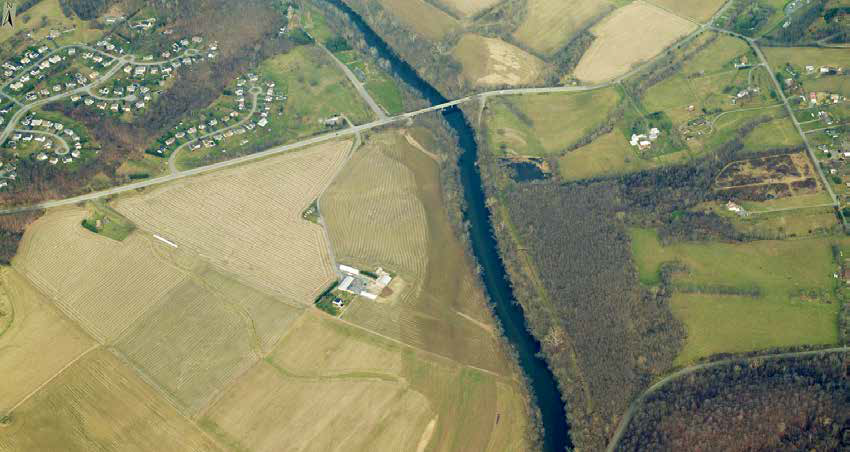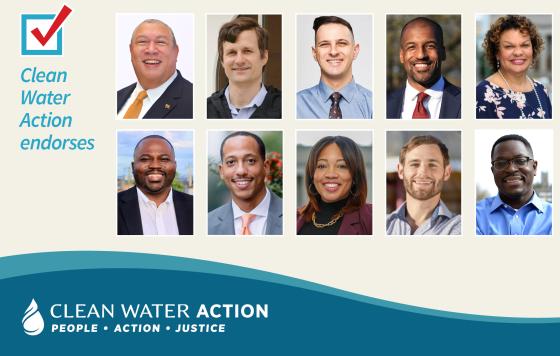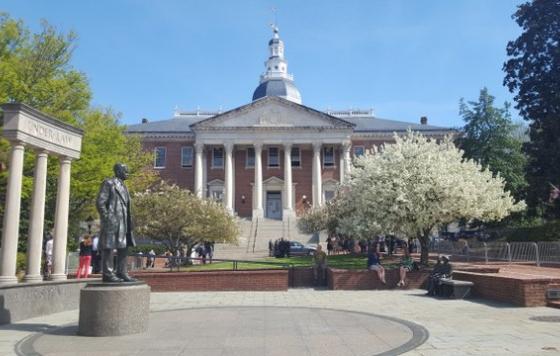
Yesterday was the latest in many public hearings about the Monocacy Scenic River Management Plan. Developed by a volunteer board of Frederick County and Carroll County Residents, the Plan is meant to outline the many water quality, land use, and wildlife habitat challenges facing the Monocacy River - one of the most polluted watersheds in the state - and recommend ways that Frederick County, Carroll County, the City of Frederick, the Town of Walkersville, and groups and individuals within its watershed can protect and improve it. But unfortunately during the hearing process for the first draft, after pushback from residents of both counties fearful of land use regulations, key recommendations for clean water protections were scrapped. At last night's hearing, we spoke out in favor of clean water protections for this important source of drinking water that remained in the plan, and stood alongside the Frederick Smarter Growth Alliance in asking that those recommendations be reinstated. Please read both sets of testimony below, and send a message to the Monocacy Board in support of clean water!
Testimony delivered by Jennifer Kunze on behalf of Clean Water Action:
Thank you for the opportunity to speak today. My name is Jennifer Kunze, and although I currently live in Baltimore, I grew up my whole childhood in Frederick - swimming in the Monocacy, looking for fish in its tributaries, and drinking its water. So I am here to speak on behalf of myself, as well as on behalf of Clean Water Action, a grassroots environmental organization with over 500 members in Frederick County. First, I would like to deliver the last handfull of a number of comments that our members have submitted during this comment period in support of common-sense clean water protections for the Monocacy River. We need the river to be clean for its environmental integrity and for swimming, fishing, and other recreation, but also for our health: the Monocacy provides almost a third of the drinking water for Frederick City and nearby parts of the County.
The Monocacy Plan clearly outlines the challenges we face with the Monocacy River. On chapter 9 page 4, you wrote, "The state of Maryland has determined ... that most waterways in the Monocacy River do not meet water quality standards." And a few pages later, you pointed out "If sediment or other pollutants or toxins in the Monocacy increase, additional strain will be placed on expensive water treatment processes and facilities." Protecting sourcewater is the cheapest and healthiest way to have clean drinking water - and the data shows that the Monocacy watershed is not getting better. The 2016 Frederick County Stream Survey results were released just last month, the latest in over a decade of reports from sampling 50 sites in the Monocacy River and Catoctin Creek watersheds for water quality data, physical habitat conditions, and biological integrity indicators. In this year's report, over half of county streams have poor or very poor biological integrity - an increase of 13% over the past eight years. And 90% of our streams show mild, moderate, or severe erosion: sending sediment straight to the Monocacy. But, this report has some good news that illustrates one of the proven ways to improve water quality: while streams with low forest cover had very high levels of nitrogen pollution, like Carroll Creek and Glade Creek, streams with high forest cover had low levels of nitrogen, like Bennett Creek. Trees work for water quality.
That's why Clean Water Action and our members strongly support recommendations to increase tree canopy cover along the Monocacy and incentivize smart land use decisions that will reduce nitrogen, phosphorus, sediment, and other pollutants in the Monocacy. As other speakers have pointed out, 35 to 100 foot buffers are proven to improve water quality, and in fact are already required by existing regulation, but are absent along much of the Monocacy's banks. In particular, we support key recommendations to protect not only the floodplain, but also steep slopes and other ecologically significant areas along the river's banks from development and impervious surfaces:
- encouraging local governments to update land use plans to preserve forest and green space along the Monocacy (chapter 6, recommendation 4)
- discourage development and encourage conservation in these areas (chapter 6, recommendation 6)
- update Frederick City's and the Town of Walkersville's flood protection ordinances to include land outside of the 100-year floodplain but still significant for a healthy watershed and flood control (chapter 6, recommendation 8)
We also strongly support the recommendations to direct existing resources and create new programs to assist Monocacy river bank landowners in creating buffer plantings on their property:
- create a Monocacy River Land Preservation Initiative in Frederick County (chapter 7, recommendation 2)
- create a new pilot program to evaluate agroforestry practices for improving water quality while improving farms' economic sustainability (chapter 7, recommendation 4)
- create a new pilot program to evaluate innovative Best Management Practices (chapter 7, recommendation 5)
- increase resources available for Agricultural Land Preservation in TMDL programs (chapter 7, recommendation 8)
- pay landowners on the Monocacy River a premium to establish new forest buffer plantings (chapter 7, recommendation 11)
We all need clean water in the Monocacy River, and I hope that you will support and enhance these vital recommendations. Thank you for your work on this important plan.
Letter delivered by Matt Seubert on behalf of the Frederick Smarter Growth Alliance:
Dear Dr. Grillon,
The Smarter Growth Alliance for Frederick County is a coalition of local and state organizations representing approximately 16,000 members and supporters in Frederick County. We engage residents and policy makers in support of wise land use that values our rural landscapes, protects our natural resources, and enhances the unique character of our towns and cities to ensure a more resilient and prosperous future.
On November 8, 2016, we sent a letter to the River Board expressing our support for the first draft of the Monocacy Scenic River Management Plan, with a suggestion that the Monocacy River Resource Protection Area (MRRPA) recommendation clearly include consideration for adopting a regulatory setback line among all four jurisdictions represented in the Plan. We received no response from the River Board.
We are writing to express our disappointment in the recent decisions made by the River Board, relating to both the substance and process of the most recent draft Monocacy Scenic River Management Plan, which no longer includes a MRRPA.
Development, certain agricultural practices, and other human-induced impacts within the watershed continue to deteriorate the Monocacy’s beauty, ecological integrity, and biological richness. The River and some of its tributaries are impaired by sediment, fecal bacteria, and phosphorus. These pollutants degrade water quality, threaten surrounding ecosystems, and reduce the viability of the River to continue meeting our drinking water needs.
The Monocacy Scenic River Management Plan is intended to enhance and protect the river corridor. While the first draft Plan, released in 2016, offered a variety of recommendations to support the River’s natural and cultural resources and to foster sustainable land uses within the watershed, the current draft omits common-sense recommendations and does far too little to
promote the health of the Monocacy River and the lands and waters feeding into it.
Primarily, we are alarmed that the MRRPA recommendation is no longer included in the current draft. The science supporting riparian buffers as vital to improving the ecological integrity of the River, including its water quality, wildlife habitat, and scenic beauty, is clear. Riparian buffers are crucial to the River’s long-term prosperity. Without a clearly delineated MRRPA on the River maps, accompanied by a stated recommendation for comprehensive regulatory adoption, it is impossible for the River Board to achieve its stated objectives as outlined by the Monocacy Scenic River Management Plan.
We are aware of landowner opposition to the MRRPA based on concerns related to private property rights. Based on the highly contentious nature of the setbacks, as well as testimony and scientific evidence presented by the public during the hearings, we acknowledge that a property-specific setback should be considered. However, we firmly believe that the benefits of riparian buffers and the vested interests of private property rights are not mutually exclusive, especially when the various compensation options available to landowners for implementing the MRRPA are considered. Many of our representative groups are available to work with individual landowners to apply for and receive compensation to implement riparian buffer plantings and other best management practices for the health of the River.
We suggest including in the Plan a new recommended MRRPA setback that adheres to the Maryland Department of Agriculture (MDA) guidelines for Best Management Practices (BMPs) related to forest as well as grass buffers. These BMPs are part of MDA’s Chesapeake Bay Water Implementation Plan (WIP) objectives.
The BMP Definition for Forest Buffers states as follows:
Agricultural riparian forest buffers are linear wooded areas along rivers, stream and shorelines. Forest buffers help filter nutrients, sediments and other pollutants from runoff as well as remove nutrients from groundwater. The recommended buffer width for riparian forest buffers (agriculture) is 100 feet, with a 35 feet minimum width required. NRCS Codes: 391, 650
The BMP Definition for Grass Buffers states as follows:
Agricultural riparian grass buffers are linear strips of grass or other non-woody vegetation maintained between the edge of fields and streams, rivers or tidal waters that help filter nutrients, sediment and other pollutant from runoff. The recommended buffer width for riparian forests buffers (agriculture) is 100 feet, with a 35 feet minimum width required. Vegetated open channels are modeled identically to grass buffers. NRCS Codes: 386, 393, 390
These BMPs were established following USDA Natural Resources Conservation Service (NRCS) practice standards which are incorporated by code references in the definitions above. NRCS codes contain technical information about the conservation of soil, water, air, and related plant and animal resources.
For example: NRCS Code 391 referenced in the agriculture forest buffer definition includes the following criteria to reduce excess amounts of sediment, organic material, nutrients, and pesticides in surface water runoff, as well as reducing excess nutrients and other chemicals in shallow ground water flow, and to create or improve riparian habitat and sequester carbon:
- The minimum width shall be at least 35 feet measured horizontally on a line perpendicular to the water body beginning at the normal water line, bank-full elevation, or the top of the bank as determined locally.
- The width will be extended in high nutrient, sediment, and animal waste application areas, where the contributing area is not adequately treated or where an additional level of protection is needed.
- The width will be extended to meet the minimum habitat requirements of the wildlife or aquatic species of concern.
- Establish plant communities that address the target aquatic and terrestrial wildlife and pollinator needs and have multiple values such as habitat, nutrient uptake and shading. The establishment of diverse native woody and herbaceous species will enhance wildlife and pollinator values.
- Select plants that have higher rates of carbon sequestration in soils and plant biomass and are adapted to the site to assure strong health and vigor.
Aerial maps of the River clearly demonstrate that these criteria are not being uniformly applied along its banks, and are indeed absent in many places. A combined 35 foot grass and 100 foot forest buffer in the MRRPA would be an optimal setback standard to provide critically needed wildlife habitat and to meet the clean water goals outlined in the WIPs for each of the four jurisdictions. This standard would need to be flexible according to topography, intensity of land use, and the habitat needs of wildlife (especially for rare, threatened, or endangered species). Since NRCS practice standards are only voluntary in nature, we feel that they should be recommended as a regulatory setback requirement in the MRRPA as previously mentioned.
The WIPs establish ongoing reductions in the Total Maximum Daily Load (TMDL) for certain water pollution inputs as mandated under the National Pollutant Discharge Elimination System (NPDES) permits required by the Federal Clean Water Act. The presence in the River of pollutants including sediment, phosphorous, and fecal bacteria in excess of their TMDLs are well documented in reports prepared by both MDE and DNR.2,3,4 These pollutants are responsible for much of the poor water quality and biological impairment in the River.5,6 In addition, MDE has identified a lack of adequate riparian buffers within agriculture areas as a major non-point source for these pollutants. Implementation of forest and grass buffer BMPs across the Chesapeake Bay watershed is crucial for achieving the TMDLs of these pollutants, thus providing clean drinking water for tens of thousands of people.
We are also troubled that the recommendation to create a community-based Monocacy Riverkeeper was removed from this new draft. While there are many local and state organizations working to protect environmental resources in Frederick and Carroll counties, there is currently no advocacy organization focused exclusively on the Monocacy River. Riverkeepers have advanced clean water – swimmable, fishable, drinkable water – in communities throughout Maryland and the world. It’s a successful model that, if implemented for the Monocacy, would likely help the counties reach their pollution reduction goals. We would consider it a good faith gesture from the River Board to re-introduce this fundamental recommendation. While the creation of a Riverkeeper organization does not require support from the River Board, a recommendation from your entity would help promote collaboration and partnership opportunities when this new stewardship group is created.
We regret that a small, vocal group was able to derail the River Board process over the past year. This group was not representative of the tens of thousands of community members who value the Monocacy River and rely on it as a source of drinking water and recreation. The River Board should have begun this entire process with a series of community meetings to acknowledge and hear from Frederick and Carroll county residents. Many of our representative groups are skilled in community outreach and engagement. We offer our services for future River Board outreach campaigns to help ensure the voice of community members influence the process, rather than the outcomes.
The River Board’s Vision Statement is to promote “a healthy, sustainable River … balancing preservation, conservation, and private property interests emphasizing cultural, historical, natural, and ecological values, including agricultural lands, while providing recreational opportunities.” Unfortunately, the River Board’s emphasis on private property interests is a completely unbalanced approach to managing the Monocacy. This approach threatens the other values described in that vision statement and endangers the very future of the Monocacy. Indeed, the River Board succumbed to a variety of arguments made that were not supported by current science and factual statements.
We urge the River Board to acknowledge the science of riparian buffers and consider the negative impacts of dirty water to all Frederick and Carroll county residents, rather than capitulating to the loudest voices at the expense of a healthy, scenic Monocacy River.
Sincerely,
Kimberly Brandt
Local Policy Director
1000 Friends of Maryland
David Curson
Director of Bird Conservation
Audubon Maryland-DC
Morgan Lakey
President
Audubon Society of Central Maryland
Alison Prost
Maryland Executive Director
Chesapeake Bay Foundation
Elizabeth Bauer
Vice President
Citizens for the Preservation of Middletown
Valley
Betsy Smith
President
Cleanwater Linganore
Jennifer Kunze
Maryland Program Organizer
Clean Water Action
Kai Hagen
Executive Director
Envision Frederick County
Janice Wiles
Board President
Friends of Frederick County
Land and Cultural Preservation Fund, Inc.
Patrice Gallagher
Board President
Frederick Zero Waste Alliance
Karla Raettig
Executive Director
Maryland League of Conservation Voters
Caroline Taylor
Executive Director
Montgomery Countryside Alliance
Caitlin Wall
Policy Director
Potomac Conservancy
Dean Naujoks
Potomac Riverkeeper
Potomac Riverkeeper Network
Steve McKay
President
Residents Against Landsdale Expansion (RALE)
James Walton Magee
Richard Jefferies
Rochdale Initiatives LLC
Daniel Andrews
Chairman
Sierra Club Catoctin Group



